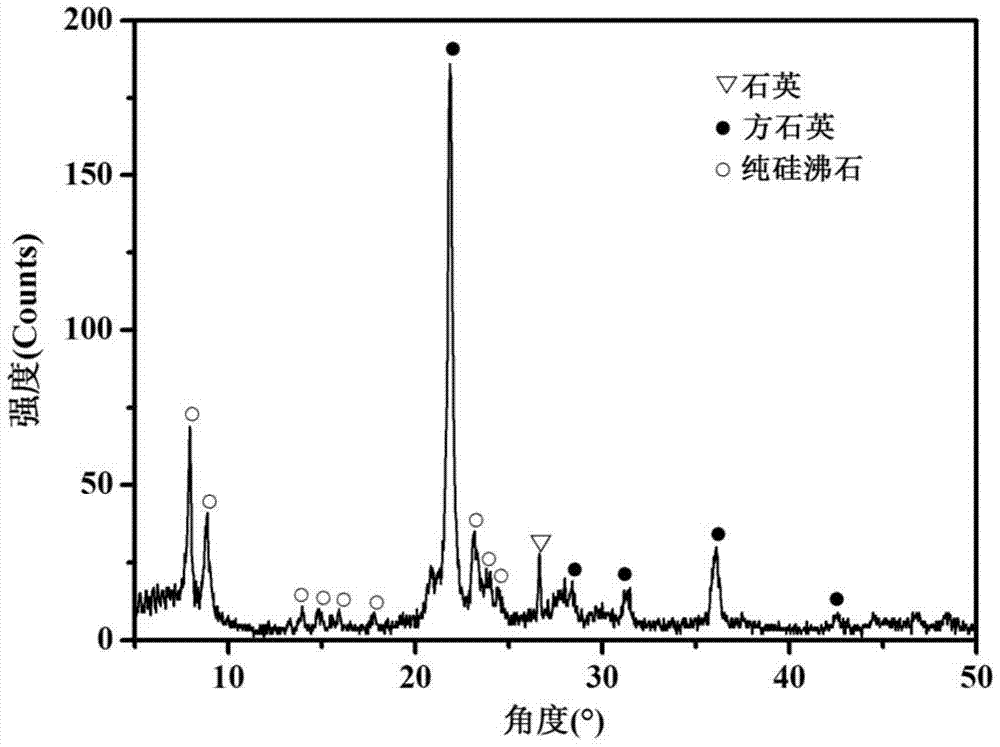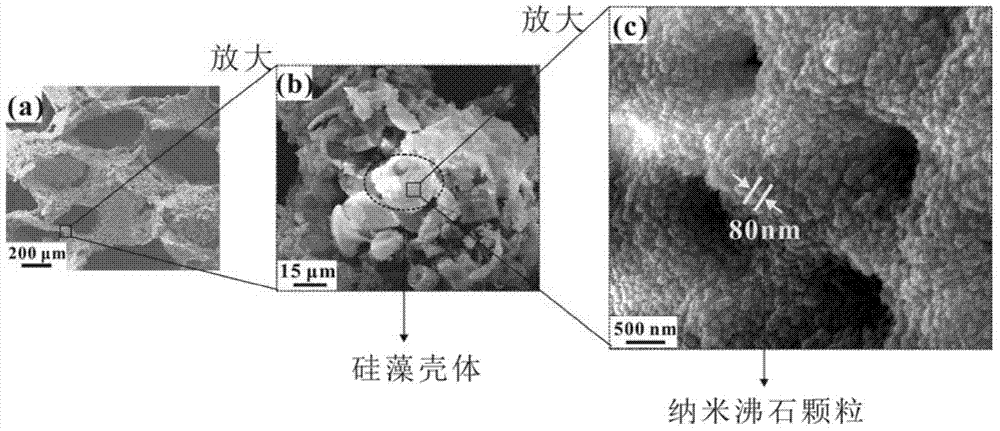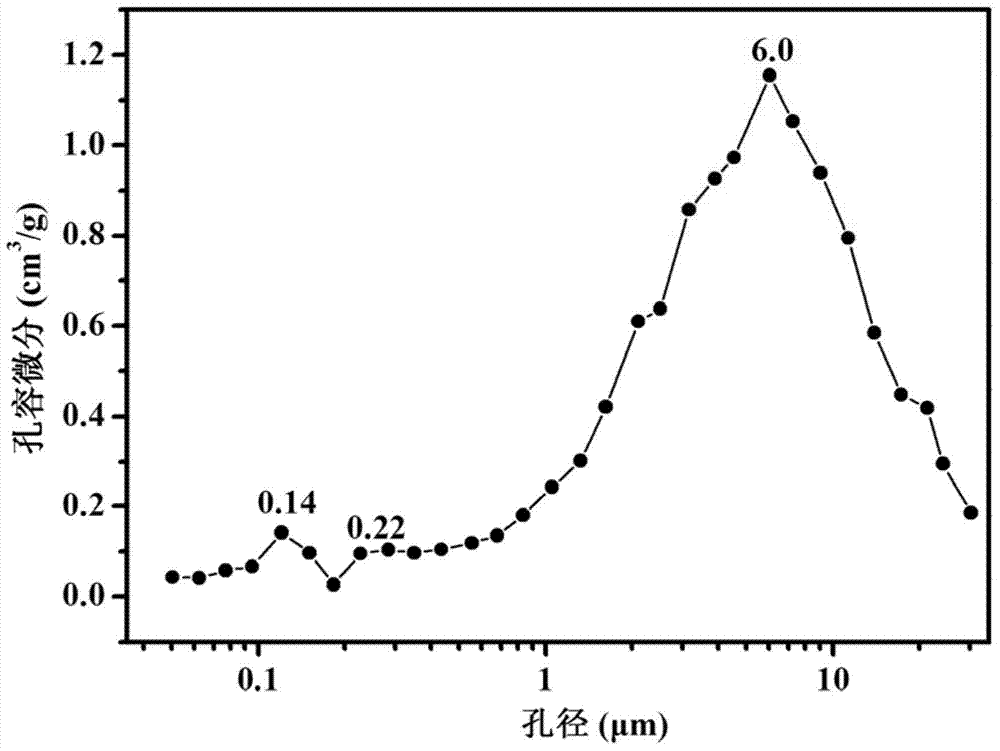Diatomite-based composite porous ceramic material for adsorbing volatile organic pollutant and preparation method thereof
A volatile organic and porous ceramic technology, applied in separation methods, chemical instruments and methods, inorganic chemistry, etc., can solve the problems of single pore structure of adsorbent, easy to be disturbed by airflow, high energy consumption in the reaction process, and achieve short preparation cycle. , reduce costs, improve the effect of VOC
- Summary
- Abstract
- Description
- Claims
- Application Information
AI Technical Summary
Problems solved by technology
Method used
Image
Examples
Embodiment 1
[0029] 1. Preparation of diatomite-based porous ceramic carrier: Take 40 g of diatomite and add it to 100 ml of additive solution, and stir thoroughly at room temperature for 15 hours to prepare a ceramic slurry. The auxiliary agent solution includes 1.8% of sodium chloride, 9.9% of sodium metasilicate nonahydrate, 5.6% of polydimethyldiallylammonium chloride, and the balance is water. Then immerse the polyurethane foam in the above ceramic slurry, vacuum impregnate for 5 minutes, squeeze out the excess slurry, repeat the vacuum impregnation and extrusion of the polyurethane foam for 3 times, after drying, heat up to 600°C at a rate of 1°C / min, and keep warm for 3 hour, and then continue to heat up to 850°C at 10°C / min, and take it out after calcination for 6 hours to obtain a diatomite-based porous ceramic carrier.
[0030] 2. Preparation of diatomite-based composite porous ceramic material: 1.5 g of the diatomite-based porous ceramic carrier prepared in step 1) is added to 6...
Embodiment 2
[0037] a. Preparation of diatomite-based porous ceramic carrier: take 40 g of diatomite and add it into 100 ml of additive solution, stir thoroughly at room temperature for 3 hours to prepare a ceramic slurry. The auxiliary agent solution includes 1.9% of sodium chloride, 6.7% of sodium metasilicate nonahydrate, 6.0% of polydimethyldiallylammonium chloride, and the balance is water. Then the polyurethane foam was immersed in the above ceramic slurry, vacuum impregnated for 10 minutes, and excess slurry was squeezed out. Continue to repeat vacuum impregnation and extrusion 5 times in this way, after drying, heat up to 800°C at a rate of 1°C / min, keep it for 2 hours, then continue to heat up to 1000°C at 5°C / min, take it out after calcination for 6 hours, and obtain diatomite-based porous ceramic support.
[0038] 2. Preparation of diatomite-based composite porous ceramic material: 1.5 g of the diatomite-based porous ceramic carrier prepared in step 1) is added to 60 ml of poly...
Embodiment 3
[0042] 1. Preparation of diatomite-based porous ceramic carrier: Take 40 g of diatomite and add it to 100 ml of additive solution, and stir thoroughly at room temperature for 15 hours to prepare a ceramic slurry. The auxiliary agent solution includes 1.7% of sodium chloride, 16.2% of sodium metasilicate nonahydrate, 5.0% of polydimethyldiallylammonium chloride, and the balance is water, based on the total mass fraction of 100%. Then the polyurethane foam was immersed in the above ceramic slurry, vacuum impregnated for 3 minutes, and excess slurry was squeezed out. Repeat this process to repeatedly vacuum impregnate the polyurethane foam, extrude it 5 times, heat it up to 550°C at a rate of 1°C / min after drying, keep it warm for 5 hours, then continue to heat up to 850°C at a rate of 5°C / min, and take it out after calcination for 3 hours to obtain Diatomaceous earth based porous ceramic support.
[0043] 2. Preparation of diatomite-based composite porous ceramic material: 1.5 ...
PUM
| Property | Measurement | Unit |
|---|---|---|
| Specific surface area | aaaaa | aaaaa |
| Total pore volume | aaaaa | aaaaa |
| Specific surface area | aaaaa | aaaaa |
Abstract
Description
Claims
Application Information
 Login to view more
Login to view more - R&D Engineer
- R&D Manager
- IP Professional
- Industry Leading Data Capabilities
- Powerful AI technology
- Patent DNA Extraction
Browse by: Latest US Patents, China's latest patents, Technical Efficacy Thesaurus, Application Domain, Technology Topic.
© 2024 PatSnap. All rights reserved.Legal|Privacy policy|Modern Slavery Act Transparency Statement|Sitemap



